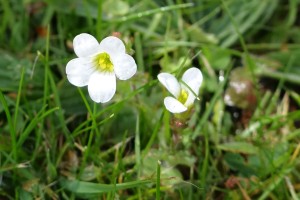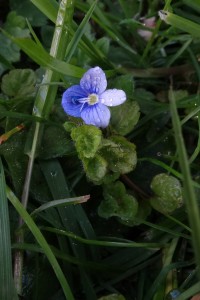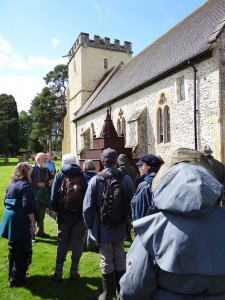While the group of 32 walkers (including 10 locals) waited for a storm to pass, Dick Greenaway provided an introduction to the walk, emphasising the importance of the geology and geography of the area on the flora that we would see. The primary issue being that, generally, woodland areas persist in places that were difficult to farm; the woodland understorey is not greatly disturbed so plants with poor seed dispersal can survive in the stable conditions.
Immediately beyond the sports ground, we found Wood Sedge, Bluebells, Lesser Celandine, Meadow Saxifrage, Wood Anemones, Moschatel (town-hall clock), Stitchwort, Yellow Archangel, Greater Wood Rush, Wood Speedwell, St John’s Wort (not yet flowering) and Dog’s Mercury. Dick reminded us that Wood Mellick is the only ancient woodland indicator that covers the whole country and that Bluebells (according to Oliver Rackham) spread 1 metre per century so take a long time to populate woodland.
He was able to confirm that the woodland was designed to enclose animals which would have been a source of food. The evidence was apparent by the fact that the ditches were dug on the inside of the boundary banks which would have stopped the deer from getting out as they would be unable to jump the ditch and over the bank in one leap.
Further into the woods we saw Deadly Nightshade, Figwort (he reminded us that ‘wort’ means ‘of medicinal or culinary use’), Herb Robert, Wood Spurge, Common Dog Violet, Bugle, Butterwort, Sweet Woodruff (smelling of newly mown hay), Wood Avens, Bush Vetch, Pignut, Spurge Laurel, White Deadnettle and Ground Ivy.
As we approached the motte, Dick explained that, according to the doomsday Book, Theodoric the Goldsmith owned the motte. The (bronze-age) field bank was still visible with the barrow (2000-2005 BC) located in the corner (to avoid using too much valuable land). Dick suggested that the Yew we were admiring could be similar age to the bank i.e. 2000 years old.
Further on, he drew our attention to Hazel coppice with Sessile Oak standards, the Hazel forcing the oak to grow straight up. Pedunculate Oak was grown in hedges. We found an Ash stool, estimated to be 400 years old, in one of the banks.
Dick showed us a potash pit (see – http://en.wikipedia.org/wiki/Potash_pit for an explanation). The production of potash in the UK was discontinued once Swedish potash became readily available as it was of a much higher quality. A similarly old woodland artefact was the lime kiln used by farmers up to 1800, in areas with readily accessible chalk. This kiln was fired to a very high temperature which resulted in the creation of quick lime around the edge of kiln which was used to make mortar.
On the route back to the car park offered up Bush Vetch, Pignut, Spurge Laurel, Three-nerved Sandwort and Ground Ivy.
The group offered their thanks to Dick Greenaway for a fascinating walk and talk.



